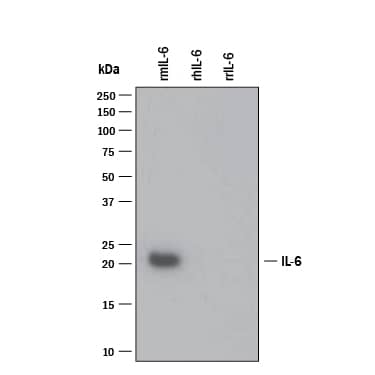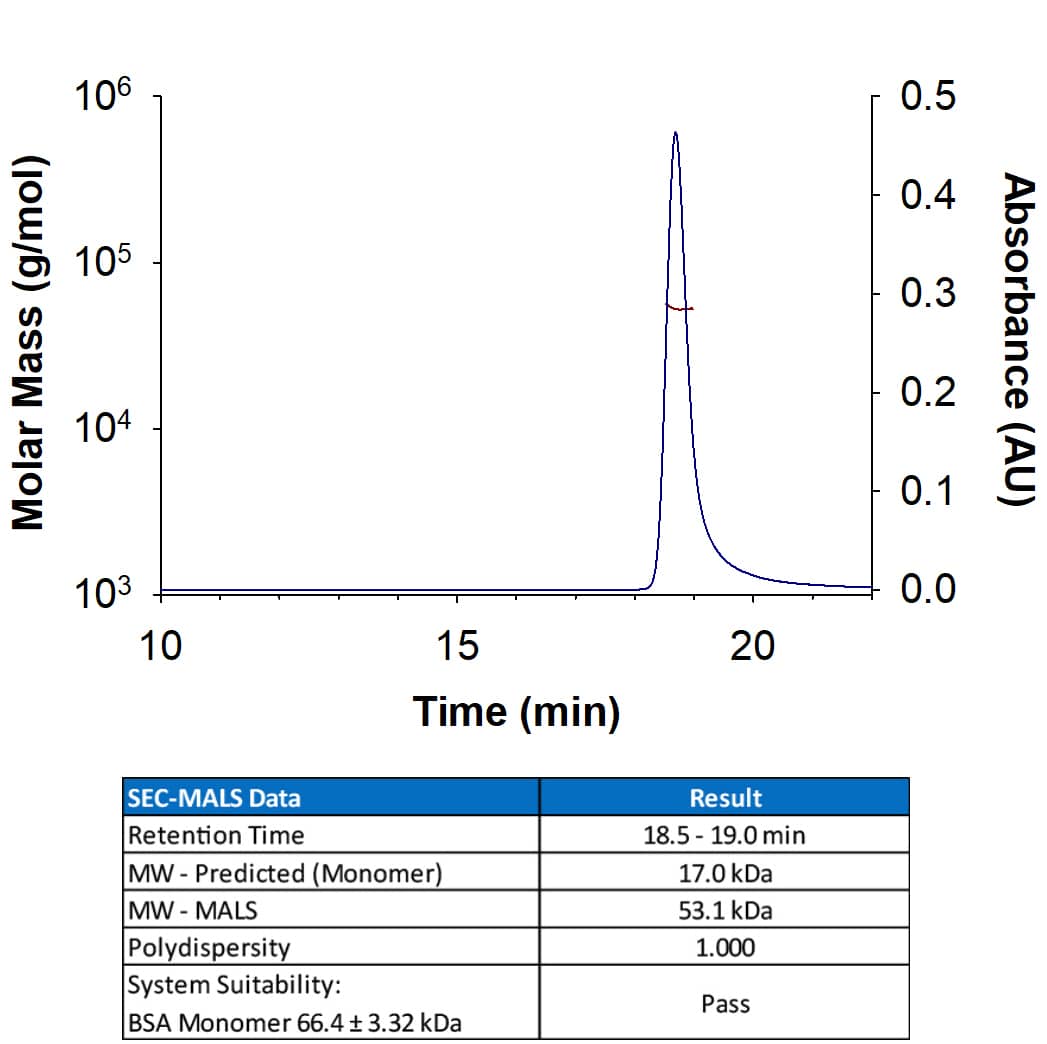Canine IL-6 Antibody Summary
Thr23-Met207
Accession # P41323
Customers also Viewed
Applications
Canine IL-6 Sandwich Immunoassay
Please Note: Optimal dilutions should be determined by each laboratory for each application. General Protocols are available in the Technical Information section on our website.
Scientific Data
 View Larger
View Larger
Cell Proliferation Induced by IL‑6 and Neutralization by Canine IL‑6 Antibody. Recombinant Canine IL-6 (Catalog # 1609-CL) stimulates proliferation in the T1165.85.2.1 mouse plasmacytoma cell line in a dose-dependent manner (orange line). Proliferation elicited by Recombinant Canine IL-6 (50 ng/mL) is neutralized (green line) by increasing concentrations of Goat Anti-Canine IL-6 Antigen Affinity-purified Polyclonal Antibody (Catalog # AF1609). The ND50 is typically 0.4-2.0 µg/mL.
 View Larger
View Larger
Detection of IL‑6 in CLL‑1390 Canine Cell Line by Flow Cytometry. CLL-1390 canine leukocytic round cell neoplasia cell line was stained with Goat Anti-Canine IL-6 Antigen Affinity-purified Polyclonal Antibody (Catalog # AF1609, filled histogram) or control antibody (Catalog # AB-108-C, open histogram), followed by Allophycocyanin-conjugated Anti-Goat IgG Secondary Antibody (Catalog # F0108). To facilitate intracellular staining, cells were fixed with paraformaldehyde and permeabilized with saponin.
 View Larger
View Larger
IL‑6 in Canine PBMCs. IL-6 was detected in immersion fixed canine peripheral blood mononuclear cells (PBMCs) stimulated with PHA using Goat Anti-Canine IL-6 Antigen Affinity-purified Polyclonal Antibody (Catalog # AF1609) at 15 µg/mL for 3 hours at room temperature. Cells were stained using the NorthernLights™ 557-conjugated Anti-Goat IgG Secondary Antibody (red; Catalog # NL001) and counterstained with DAPI (blue). Specific staining was localized to cytoplasm. View our protocol for Fluorescent ICC Staining of Non-adherent Cells.
Preparation and Storage
- 12 months from date of receipt, -20 to -70 °C as supplied.
- 1 month, 2 to 8 °C under sterile conditions after reconstitution.
- 6 months, -20 to -70 °C under sterile conditions after reconstitution.
Background: IL-6
Interleukin 6 (IL-6) is a pleiotropic alpha -helical cytokine that plays important roles in acute phase reactions, inflammation, hematopoiesis, bone metabolism, and cancer progression. IL-6 activity is central to the transition from acute inflammation to either acquired immunity or chronic inflammatory disease. It is secreted by multiple cell types as a 22-28 kDa phosphorylated and variably glycosylated molecule (1-4). Mature canine IL-6 is 187 amino acids (aa) in length and shares 76%, 59%, 38%, and 40% aa sequence identity with feline, human, mouse, and rat IL-6, respectively (5). IL-6 induces signaling through a cell surface heterodimeric receptor complex composed of a ligand binding subunit (IL-6 R) and a signal transducing subunit (gp130). IL-6 binds to IL-6 R, triggering IL-6 R association with gp130 and gp130 dimerization (6). gp130 is also a component of the receptors for CLC, CNTF, CT-1, IL-11, IL-27, LIF, and OSM (7). Soluble forms of IL-6 R are generated by both alternate splicing and proteolytic cleavage (3). In a mechanism known as trans-signaling, complexes of soluble IL-6 and IL-6 R elicit responses from gp130-expressing cells that lack cell surface IL-6 R (3). Trans-signaling enables a wider range of cell types to respond to IL-6, as the expression of gp130 is ubiquitous while that of IL-6 R is predominantly restricted to hepatocytes, leukocytes, and lymphocytes (3). Soluble splice forms of gp130 block trans-signaling from IL-6/IL-6 R but not from other cytokines that utilize gp130 as a coreceptor (4, 8).
- Van Snick, J. (1990) Annu. Rev. Immunol. 8:253.
- Hodge, D.R. et al. (2005) Eur. J. Cancer 41:2502.
- Jones, S.A. (2005) J. Immunol. 175:3468.
- Rose-John, S. et al. (2006) J. Leukoc. Biol. 80:227.
- Kukielka, G.L. et al. (1995) Circulation 92:1866.
- Murakami, M. et al. (1993) Science 260:1808.
- Muller-Newen, G. (2003) Sci. STKE 2003:PE40.
- Mitsuyama, K. et al. (2006) Clin. Exp. Immunol. 143:125.
Product Datasheets
Citations for Canine IL-6 Antibody
R&D Systems personnel manually curate a database that contains references using R&D Systems products. The data collected includes not only links to publications in PubMed, but also provides information about sample types, species, and experimental conditions.
2
Citations: Showing 1 - 2
Filter your results:
Filter by:
-
Initial Pulmonary Respiration Causes Massive Diaphragm Damage and Hyper-CKemia in Duchenne Muscular Dystrophy Dog
Authors: Akinori Nakamura, Masanori Kobayashi, Mutsuki Kuraoka, Katsutoshi Yuasa, Naoko Yugeta, Takashi Okada et al.
Scientific Reports
-
Therapeutic intervention using a Smad7-based Tat protein to treat radiation- induced oral mucositis
Authors: Boss MK, Ke Y, Bian L Et al.
International journal of radiation oncology, biology, physics
FAQs
No product specific FAQs exist for this product, however you may
View all Antibody FAQsIsotype Controls
Reconstitution Buffers
Secondary Antibodies
Reviews for Canine IL-6 Antibody
There are currently no reviews for this product. Be the first to review Canine IL-6 Antibody and earn rewards!
Have you used Canine IL-6 Antibody?
Submit a review and receive an Amazon gift card.
$25/€18/£15/$25CAN/¥75 Yuan/¥2500 Yen for a review with an image
$10/€7/£6/$10 CAD/¥70 Yuan/¥1110 Yen for a review without an image
























